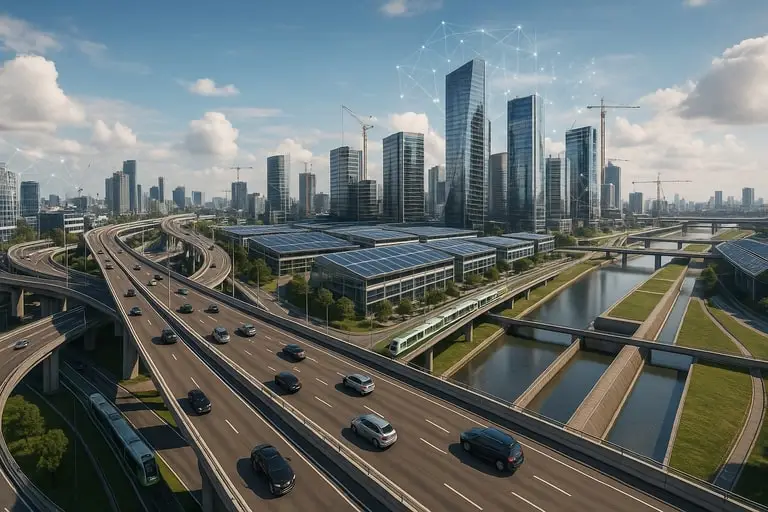Infrastructure planning is central to how societies manage growth, set priorities, and prepare for the demands of expanding populations. It is not limited to engineering tasks—it brings together construction methods, social policy, environmental foresight, and economic strategy. Without long-term vision, cities fall into cycles of congestion, inefficiency, and expensive retrofits that burden both public budgets and private businesses.
By contrast, forward-looking decisions ensure that transport systems, energy networks, and digital connectivity evolve with resilience, laying a foundation for sustainable progress. Governments and private investors now recognize that growth cannot be separated from comprehensive preparation. Coordinating housing, industry, and mobility requires synchronized investment that prevents fragmentation. Strategic planning becomes an adaptive discipline—continuous, dynamic, and directly tied to future competitiveness and quality of life.
One of its core strengths is the ability to balance competing demands. Modern cities must expand capacity while reducing environmental stress and aligning with climate goals. Projects that include renewable energy grids, green corridors, and stormwater systems address these challenges early, reducing the risks of degradation and retroactive fixes.
In this context, the building process becomes more than delivering a bridge or road—it is a responsibility to shape the kind of environment future generations will inherit. Each decision—whether about transit hubs, utilities, or zoning—represents a choice about values as much as function. Long-term planning therefore carries an ethical dimension, embedding sustainability and equity at the foundation of urban growth.
The process is also complicated by politics, budgets, and the unpredictability of technology. Election cycles often prioritize short-term visibility, while large-scale projects require decades of continuity. Many regions mitigate this mismatch through independent commissions that provide stability and nonpartisan oversight. Such institutions help align initiatives with national goals and build investor confidence. Financing models that combine public and private capital rely on this stability to secure long-term commitments.
Technology has added a new layer. Digital twins, GIS data, and AI simulations allow projects to be tested virtually, reducing costly mistakes. Adaptive systems—such as smart traffic networks or predictive maintenance—show how planning has shifted from static blueprints to flexible frameworks responsive to real-world conditions.
Equity is equally important. Poorly designed networks can deepen divides, isolating communities from jobs, healthcare, and education. By contrast, thoughtful urban development expands access and redistributes opportunity. Transit linking outer districts, affordable housing near workplaces, and broadband in underserved areas all reflect an inclusive approach that sees infrastructure as a social tool as well as a technical one.
On the global stage, pressure is rising. Developing countries must build capacity quickly, while developed nations face the challenge of modernizing aging assets under climate and fiscal constraints. Both contexts require balancing speed, resilience, and quality. International lenders increasingly condition support on strong planning frameworks, knowing that money without strategy leads to inefficiency.
Alignment across sectors is equally crucial. Energy grids anticipating electric vehicles, water systems adapting to agriculture, and secure digital networks all require integration. Fragmented approaches lead to inefficiencies, while harmonized planning maximizes resilience and long-term value.
Ultimately, infrastructure planning represents the meeting point of vision and pragmatism. It looks decades ahead, asking how societies will live, move, and work, while also demanding rigorous execution and financial discipline. Communities that adopt this approach are not just building physical assets—they are creating resilience, fairness, and prosperity for generations. Without foresight, development risks becoming reactive and costly. With it, planning transforms into a tool for shaping inclusive and sustainable futures.
Infrastructure Planning and Long-Term Infrastructure Planning
The strength of infrastructure planning lies in its ability to create systems that endure beyond a single generation. Long-term approaches consider not only today’s challenges but also scenarios that may emerge decades from now. This vision acknowledges that urban growth, demographic shifts, and environmental pressures unfold gradually yet decisively, influencing how societies function over time.
When this perspective is ignored, cities face predictable crises such as gridlocked roads, unreliable utilities, or inadequate transport. Well-prepared infrastructure plans, however, anticipate these strains and build flexibility into the system. Governments and private partners increasingly use forecasting models and generational budgeting because planning is not only about constructing assets—it is about creating adaptive frameworks that can withstand disruption.
Population dynamics add further complexity. Migration, aging communities, and evolving household structures change how people live and move. Housing designed decades ago often fails to meet modern needs. Anticipating such shifts allows planners to align transport networks, residential areas, and digital systems with future lifestyles. Thoughtful and planned infrastructure developed with this foresight helps avoid expensive retrofits and makes better use of resources.
Climate pressures raise the stakes even higher. Rising seas, prolonged heat, and water shortages demand construction strategies that prepare for conditions still decades away. Green corridors, flood-resilient systems, and robust energy grids are now part of this long-term agenda. Infrastructure planning therefore serves not just as a technical process but also as a form of climate adaptation embedded within the city fabric.
Political and financial continuity remain among the greatest challenges. Election cycles are short, while large projects may span generations. Without mechanisms for stability, initiatives risk delay or abandonment. To address this, many regions rely on independent authorities that preserve continuity and ensure alignment with national goals such as decarbonization or equitable access. These institutions also provide confidence to private investors, making governance and finance as central to planning as engineering itself.
Technology adds yet another dimension. Innovation can make rigid systems obsolete in just a few years. Smart cities depend on digital connectivity, scalable energy platforms, and modular construction methods that can evolve. Embedding adaptability into infrastructure plans prevents societies from being locked into outdated models. Today, construction strategy is as much about preparing for technological futures as about traditional building.
Equity is equally important. Decisions about where schools, hospitals, or transit lines are located will shape opportunities for decades. Neglecting underserved areas entrenches inequality, while integrating them into future plans redistributes opportunity through improved transport, affordable housing, and resilient services. In this way, infrastructure planning becomes not only a technical framework but also a driver of inclusion.
At a national scale, infrastructure is central to competitiveness. Ports, grids, and digital networks influence whether countries attract investment or lag behind. Long-term planning that prioritizes modernization and integration strengthens economic growth, while fragmented systems create bottlenecks. Construction strategy here operates as economic policy, directly shaping productivity and trade.
Sustainability further underscores the importance of foresight. Projects built without environmental considerations risk failure, regulatory backlash, and financial loss. Integrating renewable energy, low-carbon materials, and ecological corridors into future plans ensures alignment with climate goals while securing investor confidence. Today such safeguards are no longer optional—they are fundamental requirements.
Ultimately, long-term infrastructure planning allows societies to shape resilience rather than react to crises. By embedding foresight, adaptability, and fairness, infrastructure plans become durable frameworks for sustainable growth. Communities that embrace this approach do not merely endure disruption—they thrive, proving that thoughtful planning remains the foundation of lasting prosperity.
Infrastructure Planning and Urban Development Integration
Infrastructure planning and urban development are deeply interconnected, shaping how modern societies organize daily life. A long-term perspective ensures that growth is coordinated rather than fragmented. When land use, mobility systems, and construction strategy align, cities function smoothly. Without such foresight, the outcome is often sprawl, congestion, and environmental strain. With it, development becomes an engine of prosperity and resilience. Well-prepared frameworks also connect zoning and housing policy with access and affordability, making urban growth more inclusive.
Timing plays a critical role. Planning should precede expansion rather than follow it. When homes are built before transport or water systems, inefficiencies emerge. Conversely, when infrastructure plans establish the backbone of utilities, energy, and transit, new districts naturally grow around them. This proactive approach reduces the costly retrofits that burden many cities and demonstrates how forward-looking policy can guide construction strategy in harmony with social needs.
Another defining feature is scale. Local parks, neighborhood water lines, or community centers must align with regional systems like highways and power grids. If these levels are disconnected, efficiency collapses. For example, a new district without transit links undermines mobility, while a highway expansion without pedestrian access reduces quality of life. Planned infrastructure that works across scales strengthens resilience, coherence, and adaptability.
Technology enhances coordination by making complex systems visible. Geographic data, predictive analytics, and digital models show how new projects will interact with existing networks. For instance, a railway may reshape traffic flows, or stormwater management may influence housing density. Using these insights, construction firms and policymakers can ensure smoother progress and fewer disruptions.
Environmental priorities further anchor integration. Development aligned with green belts, biodiversity corridors, and resource efficiency transforms cities from consumers into balanced ecosystems. Public transit connected to ecological zones, water systems that protect habitats, and mixed-use districts that reduce reliance on cars are examples of how growth can be environmentally responsible. Without such foresight, urban areas risk worsening pollution and climate vulnerability.
Social well-being is equally important. Planning that integrates education, healthcare, and cultural access with utilities creates not only structures but also communities. Equitable access prevents districts from being isolated and ensures that opportunities are shared fairly. In this way, infrastructure planning becomes a social contract as well as a technical exercise.
Global examples highlight the contrast. Cities that grew without coordination now struggle with traffic, inequality, and pollution. Others, which embedded long-term foresight into their models—investing in transit-first systems, renewable energy, and equitable housing—have achieved greater livability and resilience. These examples show that success lies in integration, where construction strategy and urban development work hand in hand.
Ultimately, infrastructure planning establishes coherence in how societies expand. It aligns technical, environmental, and social dimensions into a single vision. By linking transit, housing, and zoning to a common strategy, urban development avoids chaos and instead reflects foresight. The result is a fabric of cities that are resilient, efficient, and inclusive—living proof that thoughtful preparation is the foundation of a sustainable future.
In the modern world, the success of every large-scale project depends not only on materials, budget, or design ambitions but on a carefully orchestrated construction strategy that provides coherence and direction. Unlike narrow technical planning, it is a broad methodology that shapes how resources are deployed, how risks are minimized, and how the vision of a project can be translated into physical reality. Without such foresight, even the most innovative designs collapse under the weight of inefficiency, delays, and escalating costs. With it, however, cities, developers, and stakeholders align behind a shared path that leads from concept to completion in a structured, reliable manner.
At its core, strategy in construction integrates multiple disciplines: engineering, economics, logistics, and environmental sciences. A project rarely exists in isolation, so every decision reverberates across surrounding communities and ecosystems. A new bridge affects traffic patterns, trade flows, and emissions; a commercial hub influences housing needs and public transit demands. That is why the underlying approach must be comprehensive, anticipating not only the immediate delivery of structures but also the ripple effects they will generate for decades. Strategic thinking in this sense becomes not simply project management but a framework for sustainable development.
One of the defining aspects of effective planning is the ability to balance short-term feasibility with long-term resilience. Investors naturally seek efficiency and timely returns, while governments and citizens look for durability, safety, and ecological responsibility. Bridging these perspectives demands transparent processes, accurate forecasting, and flexible models that can adapt to change. When properly executed, a construction strategy allows innovation to flourish without compromising stability, ensuring that structures stand the test of time while remaining financially viable. The best outcomes emerge from alignment among architects, contractors, regulators, and communities, each understanding their role within the bigger picture.
The global shift toward sustainability adds another layer of complexity. Construction is responsible for a significant share of greenhouse gas emissions and resource consumption. A forward-looking approach incorporates renewable materials, low-carbon concrete alternatives, and energy-efficient building techniques. It also embeds smart systems for water reuse, waste reduction, and energy management. This is no longer optional; it is a fundamental requirement for attracting financing, gaining regulatory approval, and earning the trust of communities. Here, strategy transforms from a business necessity into a moral imperative that redefines how societies build in an era of climate urgency.
Equally important is the role of technology. Digital twins, Building Information Modeling (BIM), and AI-driven analytics now enable planners to simulate every detail before ground is broken. These tools identify inefficiencies, predict potential failures, and optimize workflows long before they manifest in the physical world. For developers, the benefits are profound: reduced delays, minimized waste, and more precise alignment of labor and resources. For policymakers, the ability to monitor and evaluate projects in real time enhances accountability and ensures compliance. The evolution of digital tools underscores that a construction strategy is no longer static paperwork but a living, adaptive model driven by data.
Beyond technology, human capital remains decisive. Skilled labor, strong leadership, and effective communication channels determine whether even the most sophisticated strategy translates into results. Training programs, transparent governance structures, and safety protocols are essential components of this equation. Workers on the ground must understand not only what to build but why it matters within the larger context. This sense of purpose strengthens morale, reduces accidents, and fosters innovation from unexpected quarters. When people are valued as strategic assets rather than replaceable units, projects gain resilience and agility in the face of challenges.
Financing further shapes outcomes. Large-scale projects often involve complex funding models that blend public investment, private capital, and international loans. Strategy dictates how these sources are aligned, how risks are shared, and how accountability is maintained. Strong frameworks provide clarity for investors while protecting public interest, ensuring that cost overruns or unexpected disruptions do not derail progress. Transparency in funding builds trust, while innovative models such as public-private partnerships expand possibilities. By embedding financial foresight into construction planning, societies can unlock projects that might otherwise seem unattainable.
Social impact cannot be overlooked. Infrastructure does not exist in a vacuum; it defines how people live, work, and connect. Housing complexes influence demographics, roads reshape mobility, and industrial zones affect employment patterns. A responsible construction strategy accounts for these human dimensions, ensuring equitable access to resources and opportunities. Projects that ignore social implications risk community opposition, legal battles, and long-term instability. By contrast, when communities are engaged from the beginning and their needs integrated into planning, outcomes enjoy greater legitimacy and longevity.
In the end, the concept of strategy in construction is both pragmatic and visionary. It is pragmatic because it addresses budgets, schedules, and logistics with precision. It is visionary because it dares to imagine how structures will shape societies decades into the future. The true measure of success is not whether a building or bridge stands, but whether it enhances quality of life, strengthens resilience, and inspires confidence in what humanity can achieve. A well-crafted construction strategy therefore becomes more than a technical plan—it is the compass by which societies navigate growth, balance competing demands, and leave a durable legacy for generations to come.













